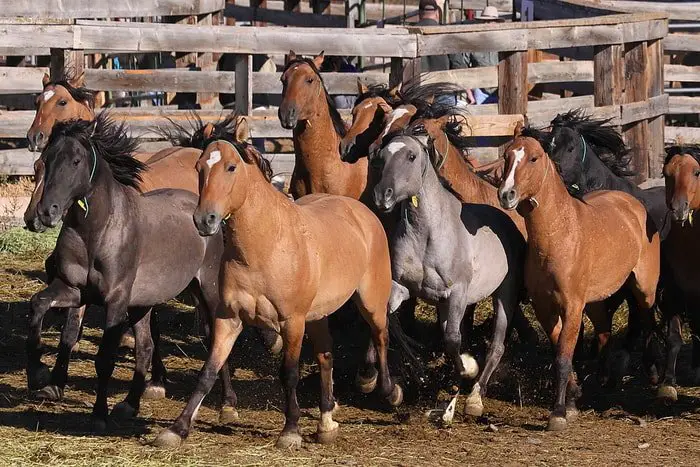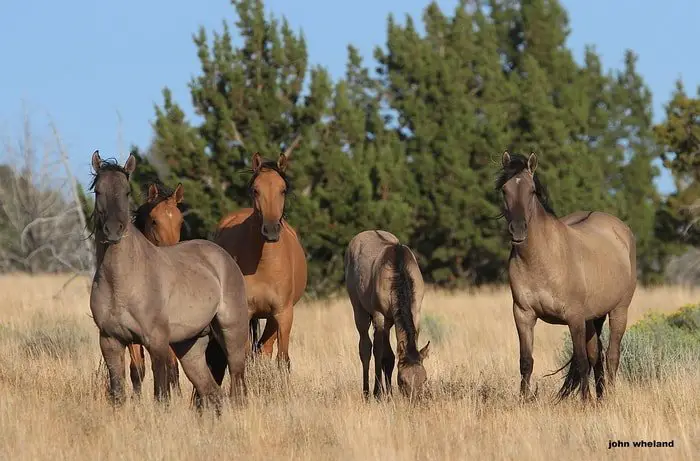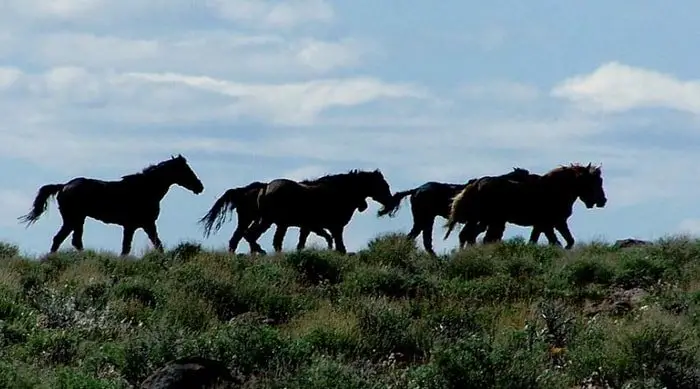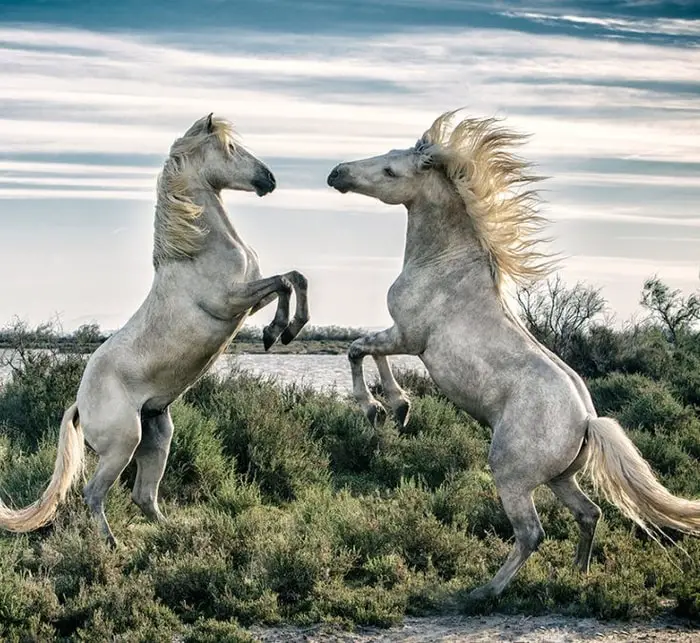A wild horse is a horse that has never been domesticated by humans and is born and lives in the Wild. They are generally free-roaming and live in natural habitats like grasslands, forests, or deserts. Some examples of wild horses include the mustangs of North America, the brumbies of Australia, and the Przewalski’s horse of Mongolia.
What is a Wild horse or Feral Horse?
On the other hand, a feral horse is a domesticated horse that has returned to the Wild or has become wild through generations of living in the Wild. Feral horses are descendants of domesticated horses that were either released or escaped from captivity and have adapted to living in the Wild. Examples of feral horses include the wild horses of the American West, known as Mustangs, which are believed to have descended from Spanish horses brought to the Americas by European settlers.
Feral horses may still retain some physical and behavioral traits of their domesticated ancestors, but they have adapted to survive in the Wild without human care.
History and Ecology of Wild Horse
Wild horses have a long and complex history, and their ecology is closely tied to the landscapes where they live. The ancestors of modern horses originated in North America and spread to other parts of the world, including Asia and Europe, before going extinct in their native continent. Horses were later reintroduced to the Americas by Spanish explorers in the 16th century, and some of these horses escaped or were released into the Wild. These horses then formed the basis of the feral populations of horses in North America today.
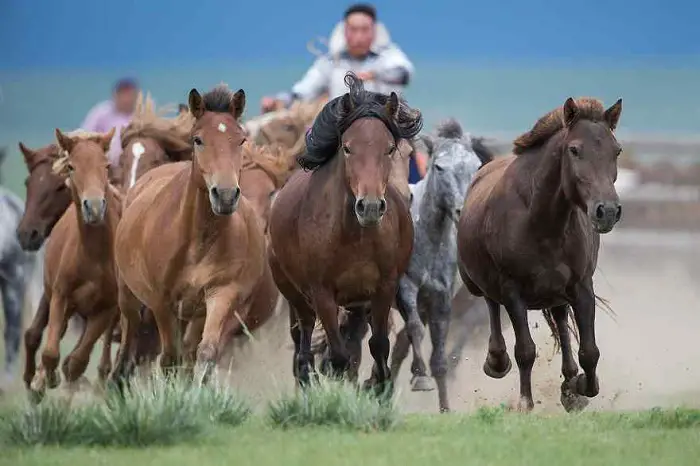
Wild horses are adapted to living in various habitats, including grasslands, forests, and deserts. They are social animals and live in herds, with a dominant stallion leading a group of mares and their offspring. Wild horses are herbivores and graze on plants, including grasses and shrubs.
Wild horses have an essential role in the ecology of the landscapes where they live. They help to distribute seeds and nutrients through their feces, and their grazing can create patches of grassland that are important for other species. However, in some areas, wild horse populations can grow too large and damage the ecosystem by overgrazing and trampling vegetation, leading to soil erosion and habitat loss.
Managing wild horse populations is a complex issue, with different stakeholders holding different views on how best to balance the needs of the horses with the needs of the ecosystem and human interests. Wildlife managers use various methods to control wild horse populations, including roundups, contraception, and relocation.
What are the Qualities of a Wild Horse
Wild horses possess various qualities that have allowed them to survive and thrive in the Wild. Some of these qualities include:
- Adaptability: Wild horses are highly adaptable and can survive in various environments, including deserts, grasslands, and forests.
- Social behavior: Wild horses are social animals and live in herds. They communicate through vocalizations, body language, and scent marking.
- Agility: Wild horses are fast and agile and can outrun predators like coyotes and mountain lions.
- Resilience: Wild horses are tough and resilient and can withstand extreme weather conditions and long periods without water.
- Instincts: Wild horses have strong instincts that help them navigate their environment, avoid predators, and find food and water.
- Stamina: Wild horses have a lot of endurance and can travel long distances searching for food, water, or new territory.
- Intelligence: Wild horses are intelligent animals and can learn quickly from their experiences and observations.
These qualities have allowed wild horses to survive and thrive in the Wild for thousands of years, and they continue to be an essential part of many ecosystems worldwide.
Evolution of Wild Horses
The evolution of wild horses can be traced back to the early Eocene epoch, around 55 million years ago, when the first minor, multi-toed mammals appeared on the planet. Over millions of years, these animals evolved into larger, more specialized forms, including the genus Equus, which includes modern horses, zebras, and donkeys.
The earliest species of Equus were small, dog-sized animals that lived in North America around 4 million years ago. Over time, these animals evolved into larger, more concentrated forms better adapted to open grasslands and savannas.
During the Pleistocene epoch, which lasted from 2.6 million to 11,700 years ago, wild horses spread across much of the world, including North America, Europe, and Asia. At this time, there were many species and subspecies of wild horses. Each adapted to its particular environment.
However, by the end of the Pleistocene epoch, many species of wild horses had gone extinct, likely due to a combination of climate change, human hunting, and competition with other large herbivores. The only surviving wild horse species today is Przewalski’s horse, which is native to the grasslands of Mongolia and China.
Today’s feral horse populations in North America, Australia, and other parts of the world are descended from domesticated horses that humans introduced. However, these horses still possess many adaptations and traits that allowed their wild ancestors to survive and thrive in the past.
Distribution of Wild Horses
Wild horses are found in various parts of the world, including North America, Europe, Asia, and Australia. Some of the most well-known populations of wild horses include:
1. Mustangs of North America: Mustangs are wild horses that are found primarily in the western United States, particularly in the states of Nevada, Wyoming, and Montana. They are believed to be descendants of Spanish horses that were brought to the Americas by European settlers in the 16th century.
2. Brumbies of Australia: Brumbies are feral horses living in the Australian Alps and other regions. They are believed to be descended from horses brought to Australia by European settlers in the 18th and 19th centuries.
3. Przewalski’s horse of Mongolia: Przewalski’s horse is the only surviving species of wild horse. It is found in the grasslands of Mongolia and China, where it lives in small herds.
4. Konik horses of Europe: Konik horses are a breed of semi-wild horses that live in various parts of Europe, including the Netherlands, Poland, and the United Kingdom. They are often used for conservation grazing, as they are well adapted to living in wetlands and other areas that require grazing management.
5. Camargue horses of France: Camargue horses are a breed of semi-feral horses that live in the wetlands of the Camargue region in southern France. They are known for their white coats and are used for herding cattle and sheep.
Wild horses are an essential part of many ecosystems worldwide and play a role in maintaining the biodiversity of their habitats. However, they can also impact the environment, mainly if their populations grow too large, leading to overgrazing and habitat degradation. As a result, the management of wild horse populations is a complex and often controversial issue.
Types of Subtypes of Wild Horses
There are several types and subtypes of wild horses, each adapted to their environment. Some of the most well-known types and subtypes of wild horses include:
1. Przewalski’s Horse: The only surviving species of wild horse native to the grasslands of Mongolia and China.
2. Mustang Horse of USA: A feral horse found in the western United States, particularly in Nevada, Wyoming, and Montana.
3. Australian Feral Horse- Brumby: A feral horse that lives in the Australian Alps and other regions of Australia.
4. Tarpan: An extinct subspecies of wild horses that once lived in Europe, believed to be the ancestor of many modern horse breeds.
5. Konik: A semi-wild horse breed that lives in various parts of Europe, including the Netherlands, Poland, and the United Kingdom.
6. Camargue Horse: A semi-feral horse breed that lives in the wetlands of the Camargue region in southern France.
7. Banker Horse: A feral horse breed that lives on the Outer Banks of North Carolina in the United States.
8. Kaimanawa Horse: A feral horse breed that lives in the Kaimanawa Ranges of New Zealand.
9. Namib Desert Horse: A feral horse breed in southwestern Africa’s Namib Desert.
Each type and subtype of the wild horse has unique adaptations and characteristics that allow it to survive and thrive in its particular environment. However, many of these horses face threats from habitat loss, hunting, and other human activities, and their populations are often subject to management and conservation efforts.
Common Wild Horse Breeds
Wild horses are not typically classified by breed since they are generally feral or descended from feral horses that have interbred over generations. However, some wild horse populations are known for their distinctive physical characteristics or regional adaptations. Some of the most well-known wild horse populations include:
- Mustangs: These wild horses are found in the western United States and are known for their hardiness and adaptability to arid environments. They are believed to be descended from Spanish horses brought to the Americas by European explorers.
- Brumbies: These feral horses are found in Australia and are known for their challenging, wiry build and ability to survive in harsh environments. They are believed to be descended from horses brought to Australia by European settlers.
- Przewalski’s Horse: This is the only surviving species of wild horse native to the grasslands of Mongolia and China. It is known for its stocky build, thick neck, and short, upright mane.
- Camargue Horses: These semi-feral horses are found in the wetlands of the Camargue region in southern France and are known for their white coats and ability to thrive in wetland environments.
- Banker Horses: These feral horses are found on the Outer Banks of North Carolina in the United States and are believed to be descended from Spanish horses shipwrecked in the 16th century. They are known for their small size, hardiness, and adaptability to coastal environments.
- Kaimanawa Horses: These feral horses are found in the Kaimanawa Ranges of New Zealand and are believed to be descended from horses brought to the country by European settlers. They are known for their hardiness and ability to survive in rugged mountain terrain.
While wild horses are not bred for specific traits or characteristics like domestic horses, they have developed unique adaptations that allow them to survive and thrive in their particular environments.
Conservation of Feral Horses
The conservation of feral horses is a complex and often controversial issue. Some people believe that feral horses should be left alone to roam freely. In contrast, others believe their populations must be managed to prevent ecosystem damage and protect other wildlife species. Some common approaches to the conservation of feral horses include:
- Habitat Preservation: One of the most important ways to conserve feral horse populations is to protect their natural habitats from development, grazing, and other human activities that can damage or destroy the ecosystems that support these animals.
- Population Management: In areas where feral horse populations are too large to be sustained by their habitats, some form of population management may be necessary. This can include fertility control measures, such as administering contraceptives or removing animals from the population through roundups or other means.
- Collaborative Management: Some conservation organizations and government agencies are working to develop collaborative management plans that involve input from various stakeholders, including ranchers, wildlife biologists, and public members. These plans aim to balance feral horse populations’ needs with those of other species and human communities.
- Research and Monitoring: Ongoing research and monitoring are essential to understanding feral horse populations and their ecosystem impacts. This can include studies of population genetics, habitat use, and the effects of feral horses on other wildlife species.
Conservation efforts for feral horses are often complex and require careful balancing of competing interests and priorities. However, with careful management and collaborative approaches, protecting these animals while preserving the ecosystems and wildlife communities that depend on them is possible.
Final Talk on Wild Horses
Wild horses, with a rich history and complex ecology, are a fascinating and vital part of our natural world. These animals have evolved over thousands of years to thrive in diverse environments worldwide, from the arid plains of the American West to the wetlands of southern France.
Despite their importance and beauty, wild horse populations face several threats, including habitat loss, fragmentation, and competition with domestic livestock. Conservation efforts for these animals must consider the complex social and ecological factors contributing to their survival, including their unique genetics, adaptations, and behaviors.
While there is no one-size-fits-all approach to conserving wild horse populations, a range of strategies, from habitat preservation to population management and collaborative planning, can help ensure these iconic animals’ long-term survival. With careful management and ongoing research, we can work to protect these animals and the ecosystems that depend on them for generations to come.
